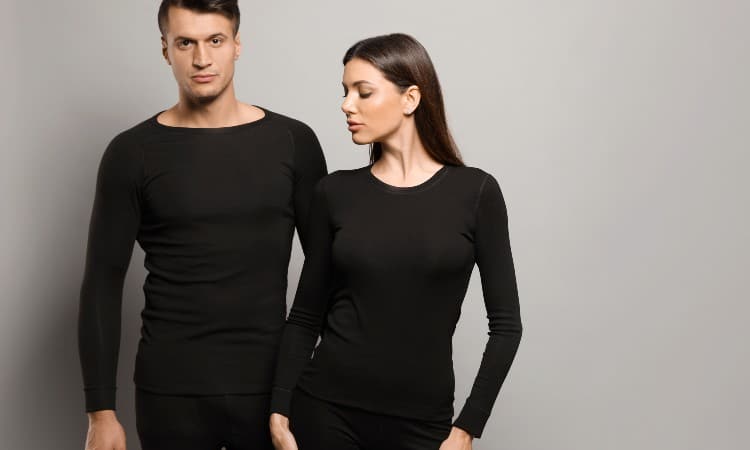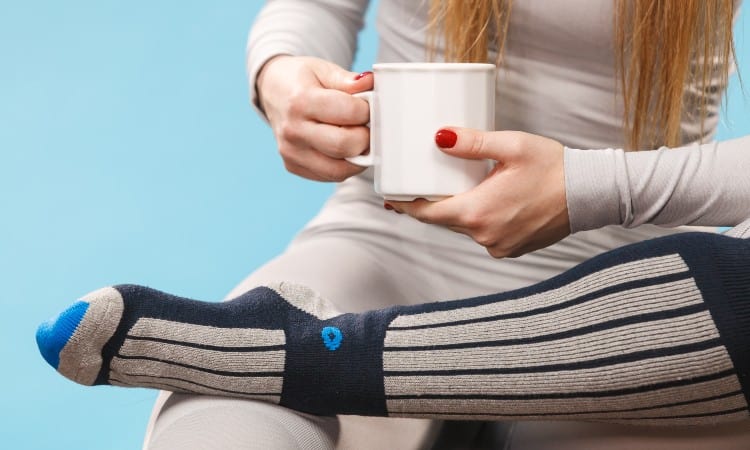As you prepare for the winter months, you may decide if your wardrobe will keep you warm enough. New winter clothes often use thermal fabric to provide extra insulation. If you want to learn about the best thermal fabric for clothing, check out this handy guide!
Thermal fabric for clothing may contain cotton or polyester and usually comes in a knit or hexagonal structure. Other popular types of thermal fabric include insulating lining materials. Filler thermals like batting and interfacing can also provide layers of warmth in a garment.
In this article, you will learn what thermal fabric does and its key characteristics. You will discover the most popular types of thermal fabric for clothing. Finally, you will find tips on how and when to wear thermal clothing!

Quick Navigation
What is Thermal Fabric?
Thermal fabric is a material that provides insulation and protection from the cold. One of the most popular types of thermal fabric is a waffle knit honeycomb-like material often used for thermal underwear or shirts worn as base layers. But this type of insulating fabric has many other uses, such as in blackout curtains that protect a home from drafts.
As a fun fact, thermal fabric using a box weave or waffle knit structure has existed since the late 1700s. It became popular as the material used in “Long Johns.” a kind of full-body undergarment with long sleeves and legs.
In the early years, this garment typically featured either wool or cotton woven in a structure with dimension to it, allowing it to trap pockets of heat against the body. By the 20th century, the development of synthetic fabric meant that this thermal material could also gain moisture-wicking properties.
Another key thing to know about thermals is that you can find several different kinds of fabric that serve as insulators. Many of the materials used to line coats and jackets are thermal fabrics, for example. Thermal linings often have polyester or synthetic fabric base and a layer of aluminum or plastic on the other side.
Then you have filler material, such as the batting used inside quilts, coats, and jackets, that traps heat in its fine threads and packs on lots of insulation.
You can find thermal fabric made out of many different types of material, ranging from polyester to silk. The most common material used in thermal cloth is a blend of polyester and cotton, though. Depending on the type of garment, you may also find a small percentage of spandex or Lycra in the blend.
Thermal undergarments worn as a base layer need to do more than provide warmth. You want them to feel comfortable and stretchy when you move and wick moisture away if you get sweaty! This is why so many thermal undergarments use synthetic fabrics.
The weight of the fabric can also play a role in determining how much insulation it provides. Thermal knits, for example, often come in a light, mid, and heavyweight option. The heavier the knit, the more insulation it will provide!
Characteristics of Thermal Fabric

Thermal fabric comes in many structures and weights, but it always provides an element of insulation. Check out its other key characteristics, including its typical cost, popular uses, and ease of care.
Insulation
The most important characteristic of any thermal fabric is how well it insulates against the cold. Though you can find thermals made out of varying types of material and in different structures, one key concept connects them all. Every thermal material has a structure designed to trap heat within itself.
Thermal knit fabric is a great example of this concept. If you look at the surface of this fabric closely, you can see an almost 3D structure of ridges and dips, often in box, hexagonal, or waffle-like patterns. All these tiny cells within the material will hold heat pockets against your skin, keeping you warm!
Thermal batting, which is the stuffing used inside some cold-weather garments, often uses specialized polyester filaments that have hollow cores. The hollow cores trap heat in tiny pockets as well.
However, it is also important to note that nearly all garments made of thermal fabric work best when worn in layers. Thermal undershirts would not keep you super warm if you went on a winter jog wearing nothing else! The heat-trapping properties work most effectively when you wear a thermal as a base layer and layer other garments on top, sealing all the heat against your skin.
Breathability
The breathability of thermal fabric describes how well moisture and air can flow through it. Some types of thermal fabric offer a lot more breathability than others.
Thermal knits today typically feature synthetic fabrics in special structures that can easily wick moisture from your skin and allow it to evaporate in the outside air. This property enhances the breathability of garments, often worn as a base layer while you jog or play soccer outside on a chilly day.
Other types of thermal material, such as the linings in coats or the heavily coated fabric used for blackout curtains, do not provide much breathability on purpose. These types of fabric are intended to block the flow of air, trapping all the heat on one side of the fabric.
Strength
The strength of thermal fabric depends on many factors, including what material it contains and what kind of woven or knitted structure it uses. Thermal knits usually have a pretty good tensile strength that can withstand lots of activity. Thermal interfacing is not designed to resist twisting or tearing as much, but it does not need to from its safe position inside a garment!
Wrinkle Resistance
Thermal knits do not wrinkle, especially if you get a garment made primarily out of polyester. If you get pricer knits made out of merino wool or another material, the winkle resistance may vary.
Other kinds of thermal fabric, such as the thick, lined thermals used for curtains, may wrinkle more easily. The knit structure helps this fabric resist wrinkling, so plain weave fabric may crumple up to a greater degree.
Ease of Care
Most thermal fabric allows for very easy care. This does depend on the material used in the fabric, though. For example, most thermal knit underwear or undershirts you buy contain polyester or cotton, making them washable and safe to put in the dryer. But if you buy a high-end set of thermal undershirts made of wool, you may need to take them to the dry cleaner!
Cost
Thermal fabric by the yard costs between $10-$20, depending on its weight and the material used in the cloth. Thermal clothing such as a “long johns” style undershirt often cost under $15, though this also depends on the brand and the material’s quality.
Athletic wear, such as thermal shirts with four-way stretch, or extra-comfortable thermal clothing with a soft brushed surface on the fabric, may cost a bit more. Once you get into winter coats made with special “warmth tech’ textiles, the prices will skyrocket and you will easily need to spend at least $200 on a coat.
Popular Uses
The most popular use for thermal fabric is in undergarments intended for use as a base layer. These insulating fabrics keep you warm as you sleep or add a layer of protection when you work outside in the winter.
Other popular uses for thermal fabrics include providing a lining inside coats or jackets for added warmth or serving as an insulating filler material within clothes or other items.
Thermal fabrics also have several non-clothing uses, such as creating draft-blocking window treatments or providing a heat guard in things like potholders or lunch boxes.
Best Thermal Fabric for Clothing

The best thermal fabric for clothing includes options like thermal waffle knits for undergarments, special high-tech thermal materials for athletic wear, and thermal linings for coats.
Thermal Knits
Thermal knits usually contain polyester or cotton in a layered knitted structure that can use a honeycomb, waffle, or box-like stitch. You can even create a thermal stitch yourself using knitting needles on a larger scale to create extra-warm sweaters!
Thermal knit fabric can come in lightweight, medium-weight, or heavyweight structures. The most popular use for thermal knits is in undergarments or base layers, often using a light or medium-weight version. The only time you would want a heavyweight thermal knit as a base layer is if you plan to spend many hours outdoors in intensely cold weather!
Cotton Thermal
Cotton thermal knit fabric remains popular today because it provides excellent breathability and feels soft against your skin. It may not provide as much warmth as a polyester thermal knit. For this reason, you can also find some brands that sell underclothes made out of blended cotton and polyester.
Polyester Thermal
Today, the bulk of thermal knit clothing sold contains at least a large percentage of polyester. This synthetic material costs significantly less than cotton and provides a bit more warmth.
Are polyester thermals warm? Yes, though, of course, this does depend on the quality of the construction and the knit of knitted pattern in the fabric. It also depends on the weight of the material, as a heavyweight polyester knit has greater bulk and many more knit pockets to trap warm air than a lightweight version.
Athletic Thermals
These days you can find a huge variety of athletic or “warmth tech” fabrics that use advanced textile science to provide extra layers of insulation to winter athletic wear or coats. These fabrics use the basic concept of creating fibers with hollow cores that trap heat, but they can contain different types of materials.
For example, some brands sell athletic insulating clothes made out of coffee bean shells infused with proteins from wool, while other brands like NorthFace offer insulating garments made using the more common polyester microfiber and thermal filling.
Underarmor also offers microfleece garments made of polyester, but some of their products contain fine ceramic strips to retain body heat.
Interestingly, not all high-tech thermal fabric uses the traditionally knitted structure for the fabrics. Some newer types of material do not weave the threads in the fabric together at all–instead, they use a special crimping machine to turn loose fibers into a slightly bunched-up material that traps heat!
Thermal Batting
 Thermal batting is a special type of polyfill that uses needle-punched polyester fibers with hollow cores. You typically find this material inside potholders, quilted baby snuggies, and ironing board covers.
Thermal batting is a special type of polyfill that uses needle-punched polyester fibers with hollow cores. You typically find this material inside potholders, quilted baby snuggies, and ironing board covers.
You can also purchase it by the yard from brands like Insulbrite if you want to make your own insulated items! Insulbrite thermal batting has a double-sided layering and contains hollow polyester fibers with metallicized polyester centers for extra insulation.
Thermal Interfacing
While it is less common than thermal filling in coats, some thermal garments use a special type of interfacing that provides additional insulation. Interfacing is a stiffened interior fabric that provides structure or body to the inside of a garment. When layered between a piece of outer fabric and a lining, it can provide extra insulation for a coat or jacket.
Brands like Thermoweb sell interfacing you can purchase to add to warm garments such as jackets or to add definition and insulation to a quilting project!
Waterproof Thermal Fabric
 A few highly advanced fabric brands, such as NikWax Analogy, sell material that has a waterproof coating and provides insulation inside. However, what you see much more frequently is a garment that has a poly-coated outer shell for waterproofing and then separate layers of insulating material on the inside.
A few highly advanced fabric brands, such as NikWax Analogy, sell material that has a waterproof coating and provides insulation inside. However, what you see much more frequently is a garment that has a poly-coated outer shell for waterproofing and then separate layers of insulating material on the inside.
For example, most ski jackets like this one combine a densely woven protective polyester shell with thermal batting inside to provide warmth and waterproofing.
What this means in practical terms is that garments with both waterproofing and thermal elements often do not provide as much breathability as many other thermal fabrics. This is because the waterproof layer must remain solid to prevent moisture from getting through.
Quilted Thermal Fabric
 Quilted thermal fabric features two thin layers of cotton or polyester with batting sandwiched in between and rows of stitching to hold all the layers together. This material can provide insulation, but it is used more often to protect you from heat, as in the case of oven mitts or placemats on the table.
Quilted thermal fabric features two thin layers of cotton or polyester with batting sandwiched in between and rows of stitching to hold all the layers together. This material can provide insulation, but it is used more often to protect you from heat, as in the case of oven mitts or placemats on the table.
You can also buy quilted thermal material by the yard from brands like ThermaFlec if you want to design your own protective table mats or oven mits!
Which Material is the Best Insulator?
It is difficult to find a clear answer to the question of which material is the best insulator because different thermal fabrics work best in different circumstances. For example, thermal knits work best as insulation for base layer clothing, but thermal batting can provide warmth inside a ski jacket much more effectively than a thermal knit.
If you consider the insulating abilities of fabric fibers on their own, wool wins most of the tests for retaining the most heat. Polyester does pretty well, as does cotton. But neither can hold a candle to the insulating properties of wool fibers.
You have to remember, though, that the fabric structure matters even more than the type of fibers it contains. Thermal knits provide tons of insulation whether they contain cotton or polyester–you don’t have to shell out for fancy wool thermal knits unless you want to!
On top of that, in recent years, many highly advanced thermal textile products have hit the market. These use technologies like crimped fabric that holds heat in special pockets or hollow-core polyester fibers inside microfleece.
The bottom line is that if you want to determine what is the warmest thermal material, you will first need to know if you want it for a base layer of clothing, a lining in your coat, or a high-tech hiking jacket made out of advanced thermal fabrics.
Which Fabric is Warmest in Winter?

The warmest fabrics to wear in winter include wool, thermal knits, and specially designed thermal technology materials like HEATTECH or Nanostitch.
A really simple way to choose the warmest fabrics for winter is to think about the material used in the fabric and the structure of the fabric.
The material used matters because the type of fibers determines how much heat the fabric can retain. Wool fibers hold a ton of heat, for example, while nylon or polyester hold less. The structure of the fabric should have properties that create hollow shapes or pockets inside it to trap bubbles of hot air as well.
This means that something as simple as a knitted wool sweater can provide excellent warmth in winter, because the wool fibers will retain heat, and the knitted pattern has plenty of pockets to trap hot air!
More advanced products like the proprietary fabrics called HEATTECH and Nanostitch use special production methods to make lightweight fabrics perfect for winter coats. These kinds of cloth contain heat-sealing elements such as hollow polyester fibers or yarns soaked in a type of protein from wool called polyamides. These super pricey fabrics have the benefit that they can keep you warm on their own, without lots of layering beneath.
The most common way to use thermal fabrics is to wear the thermals as a base layer and apply a layer of outwear on top.
Thermal Fabric for Windows
 You can find several effective kinds of thermal fabric for windows, such as insulated shades with a thermal lining or thermal fabric for blackout curtains.
You can find several effective kinds of thermal fabric for windows, such as insulated shades with a thermal lining or thermal fabric for blackout curtains.
Windows shades like this set by ChrisDowa have a PVC outer coating to block sunlight and a fleecy, thermal lining that blocks chilly drafts leaking through the glass windowpanes.
Thermal curtains like this set by Nicetown offer a dense triple-weave polyester fabric that can block UV rays and insulate a room from cold weather. Many thermal curtains use dense polyester and a poly coating inside for extra draft protection.
If you want to make your own thermal window treatments, you can find thermal fabric by the yard online or from fabric stores such as Joann Fabric.
What Temperature Should You Wear Thermals At?
The general rule is that it’s a good idea to wear thermals if you plan to go outside for more than half an hour in temperatures below 50℉. This does depend significantly on your own comfort level with the cold, though. If you like brisk fall air, you may want to save the thermals for below-freezing temperatures instead.
The number of layers you wear on top of your thermal knit base layer will also impact when you should wear them. For example, if you want to wear a ski jacket on top of your base layer, you may want to wait till temperatures drop below freezing outside.
Finally, many thermal products, especially winter coats, will have a temperature rating. This will tell you that a garment should keep you warm in temperatures as low as 10℉, and so on. This gives you a clear idea of when you should wear that coat.
Can You Wear Thermals on Their Own?
Recent trends inspired by the athleisure craze and popular sports stars like David Beckham encourage people to wear thermals on their own. That said, this depends on the garment’s style and the outdoor temperature.
Many popular brands like Lands End and NorthFace do sell thermal garments that you can wear on their own as shirts or pants. These do not look like undergarments and have a casual loungewear style that you can wear at home or even run errands if it is not too cold outside.
On the other hand, traditional thermal knit garments like a pair of Long Johns look very pajama-like and probably would not make the best choice for wearing outside of the house on their own!
Another factor to consider when deciding if you want to wear thermals on their own is the temperature. Thermals do their best work keeping you warm when worn with other layers, in most cases.
This means that you would not necessarily want to go on a winter hike wearing nothing but thermals. Instead, wear them as a base layer and wear jeans and a hiking jacket.
Finally, most thermal garments intended for use as a base layer work best when they fit close to your skin. You may feel uncomfortable going out in public in a skin-tight shit, and throwing on a flannel button-down over it can keep you warmer and more comfortable at the same time!
Conclusion
The best thermal fabric for clothing includes thermal knits and high-tech thermals for athletic wear. Each type of thermal cloth works best in specific situations, such as thermal batting inside a coat or quilt vs thermal knits in long johns. You will also find thermal fabrics in many popular household items like blackout curtains and oven mitts.
The most important factors to consider in thermal fabrics are the type of fibers it contains and the structure of the cloth. One of the most popular types of fiber to use in thermal fabric is polyester fibers with hollow cores. Most thermal fabrics use a knitted or crimped structure with many tiny pockets to trap hot air.